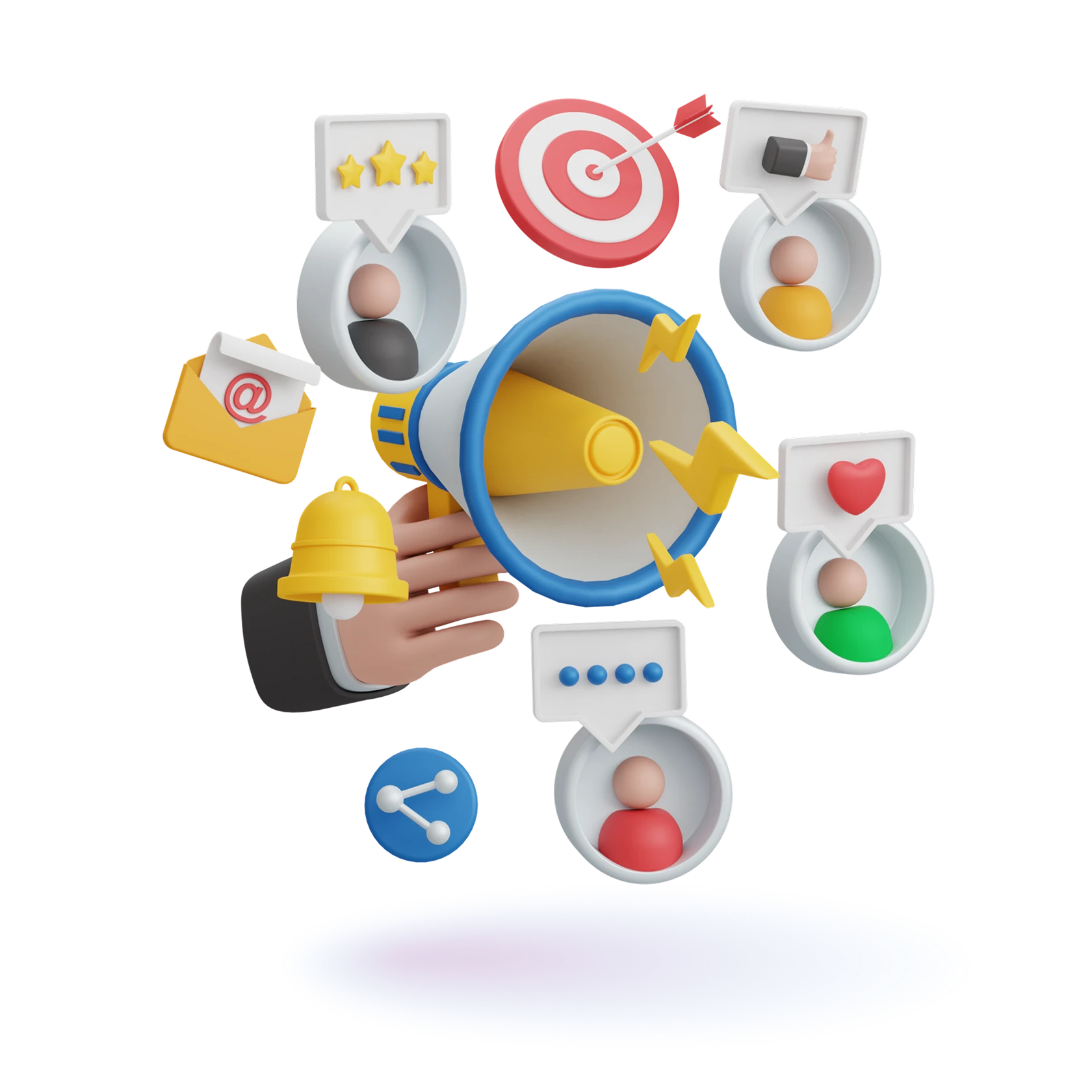If you’re still relying on one channel to reach your prospects, you’re already behind. Buyers today want relevant, consistent, and personalized experiences across all interactions with your brand. One email sequence or a LinkedIn campaign isn’t enough to stand out anymore.
Omnichannel lead generation involves meeting your prospects across various touchpoints while maintaining a consistent message. It’s the foundation of a modern lead generation strategy that aligns every channel to how buyers actually make decisions.
The State of B2B Outreach in 2025
The numbers tell the story: email reply rates are shrinking year after year. What used to bring a steady flow of qualified replies now often gets ignored or sent straight to spam folders. LinkedIn, once the goldmine for outbound marketing, is now overcrowded with pitches, spammy InMails, and copy-paste connection requests. The result? Decision-makers tune out.
However, their attention hasn’t disappeared; it’s just spread more thinly across multiple channels, which is exactly why omnichannel lead generation outperforms siloed efforts. Your prospects might skim their inbox in the morning, scroll LinkedIn at lunch, catch a podcast ad on the way home, and open a retargeting ad later that night. If you’re not present in those moments, someone else will be.
Businesses using three or more channels see 287% higher purchase rates compared to single-channel campaigns. This is one of the clear benefits of omnichannel lead generation: consistent engagement and stronger conversions across touchpoints.
Core Channels for Omnichannel Lead Generation
Omnichannel lead generation means selecting the optimal mix of channels where your buyers already spend their time and ensuring those touchpoints work seamlessly together. Compared to multichannel lead generation, where activities often run in silos, omnichannel ensures every interaction supports the next.
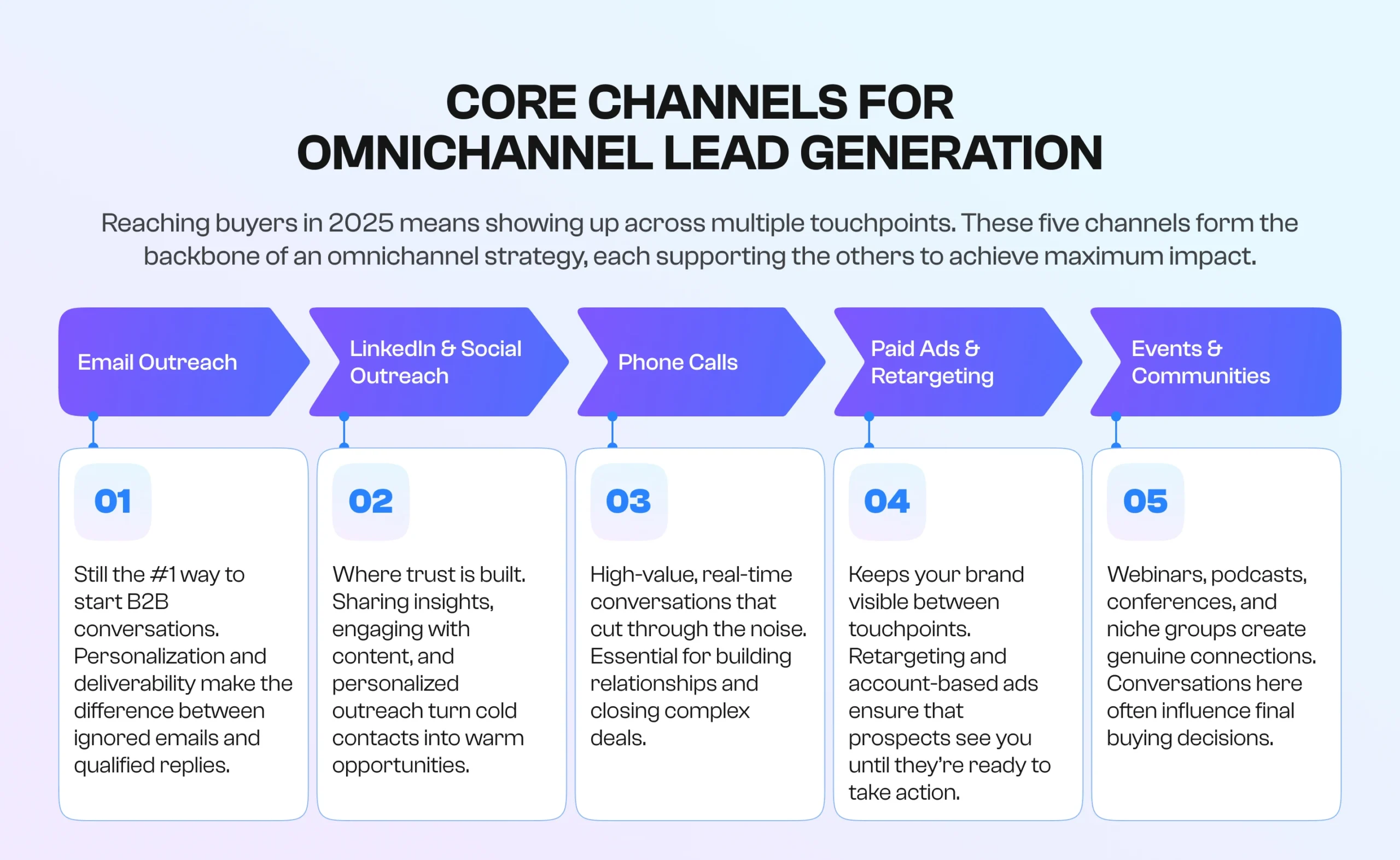
Email Outreach
Email isn’t dead, far from it. Despite inbox overload, it remains the number one channel for initiating B2B conversations. The problem is, most teams are treating email like it’s 2018: batching templates, blasting them to huge lists, and wondering why reply rates sink below 1%.
Personalization that Feels Human
We’re past the era when simply slapping a prospect’s name or company into the subject line was considered personalization. Decision-makers can smell automation from a mile away. Personalization today means relevance: understanding their role, their challenges, and their current stage in the buying journey.
For example, referencing a prospect’s latest product launch or mentioning a recent funding round shows that you’ve done your homework. But there’s a balance: over-personalizing with creepy detail backfires. The sweet spot is specific, but professional, showing that you’ve invested time, not stalked their LinkedIn feed for family photos.
Deliverability as a Dealbreaker
You can write the smartest email in the world, but if it lands in spam, it’s worthless. Deliverability in 2025 is a daily discipline. Setting up DMARC, SPF, and DKIM is the bare minimum. Warming up domains, rotating sending accounts, and monitoring health scores are now part of the SDR playbook.
Tools like Folderly, GlockApps, and MailReach have gone from “nice-to-have” to mission-critical. Without them, your campaign might be invisible to 70% of your audience. Companies that invest in deliverability optimization see reply rates improve by up to 3x, simply because their emails reach inboxes consistently.
Sequencing for Modern Attention Spans
The old five-step sequence (“intro → follow-up → bump → breakup → last chance”) doesn’t cut it anymore. Prospects expect a mix of value-driven emails. Adding case studies, insights, or even relevant industry news in follow-ups makes your outreach feel less like spam and more like a resource.
Here’s what works today:
- Short, sharp openers (2–3 sentences max).
- Follow-ups with supporting evidence (statistics, testimonials, case results).
- Creative re-engagement (a question, a fresh angle, or even humor).
AI, But Not on Autopilot
Yes, AI has changed the game. Tools like Lavender, ChatGPT, or Clay make it easier to draft hyper-personalized messages at scale. But here’s the reality: AI is a co-pilot, not a replacement. Prospects can tell when every word is machine-written. The best teams use AI to generate drafts, enrich data, and suggest angles, but a human eye always gives the final touch.
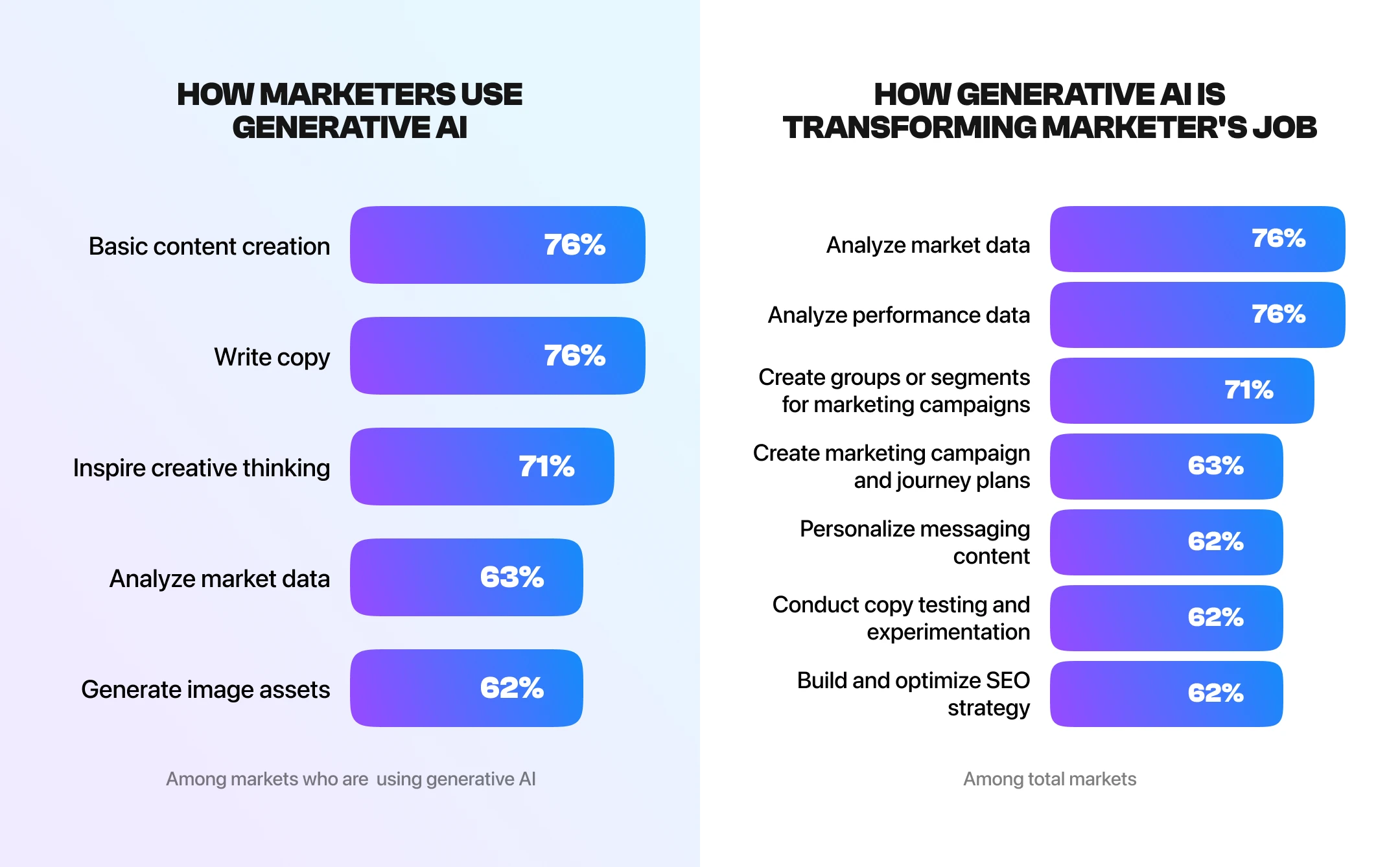
Want to see how AI can boost your outbound results without losing the human touch? Read our complete guide on using AI for lead generation.
Email remains the backbone because it scales better than any other channel, it’s measurable, and it reaches decision-makers directly. In fact, 73% of buyers still prefer email for B2B communication.
Spray-and-pray is dead. If you don’t master personalization, deliverability, and sequencing, your competitors will. But if you do, email becomes the workhorse that powers the rest of your omnichannel lead generation engine
See how SalesAR’s omnichannel approach can deliver results.
LinkedIn & Social Outreach – Trust First, Pitch Later
If email is where the first touch often happens, LinkedIn is where trust is built. You can’t afford to treat LinkedIn like a mass messaging tool. Buyers are drowning in connection requests that scream “I’m about to pitch you.” What works today is slower, more deliberate, and focused on giving value before asking for anything.
Thought Leadership as a Magnet
Decision-makers are far more likely to respond if they’ve already seen your name pop up with useful insights in their feed. Consistent posting positions you as someone worth listening to.
This doesn’t mean every SDR has to become a content creator overnight, but aligning your sales team with marketing helps. Repurposing blog posts into LinkedIn carousels, sharing client wins, or commenting meaningfully on industry debates helps keep your profile active. That way, when a connection request or message does arrive, it feels natural, not intrusive.
Smarter Outreach, Not More Outreach
LinkedIn has tightened the screws on automation. Spam tools that used to blast hundreds of requests a day now risk getting their accounts banned. The ceiling is lower, which means that every connection request must be carefully considered. Personalization is just as crucial here as in email — mentioning a shared group, mutual connection, or a specific reason for connecting.
And the first message? Skip the pitch. A quick “Saw you’re leading expansion at [Company], curious how you’re approaching [topic]” works far better than dropping your calendar link upfront.
Response rates hover around 10–25% when personalized, compared to under 3% for generic messages.
The Role of Video and Voice
Short-form video is increasingly being used in B2B outreach. A quick, personalized Loom video explaining why you reached out or commenting on a prospect’s recent initiative can significantly boost reply rates. Personalized videos increase response rates by up to 8x compared to text-only outreach.
Social Outreach That Supports the Funnel
Think of social outreach as both a direct channel and a support system for all other initiatives. When a prospect sees your email, they might check your LinkedIn profile before replying. If it looks empty, you lose credibility. If it’s full of useful posts, client stories, and mutual connections, you gain trust instantly.
That’s why the most effective teams don’t silo LinkedIn from email or ads. They connect the dots:
- Email introduces you
- LinkedIn warms you up
- Ads reinforce awareness
- Calls close the loop
People buy from people they trust. Trust is built through repeated, positive interactions across various channels. Done right, omnichannel outreach on LinkedIn and social platforms turns those touchpoints into credibility builders, rather than just noise.
LinkedIn and social outreach deliver those micro-moments of credibility that make everything else easier. Ignore them, and your emails will feel colder, your calls will be harder to make, and your ads will be less effective, weakening your omnichannel lead generation as a whole.
Phone Calls – High-Value Conversations That Still Close Deals
For years, people have been predicting the death of cold calling. Yet here we are in 2025, and the phone is still one of the strongest tools for omnichannel lead generation. Why? Because nothing beats a real-time, two-way conversation when it comes to building trust and qualifying opportunities.
The inbox can be ignored, a LinkedIn message can sit unread, but when you’ve got someone’s voice on the other end of the line, you’ve created a moment that demands attention.
The Human Advantage
Buyers crave authentic interaction. Email and LinkedIn can feel transactional, even with personalization. A phone call, however, is personal by default. Tone, pacing, and empathy go a long way in showing prospects you’re not just reading from a script.
That doesn’t mean blasting through a list with robotic pitches works. If you’ve done your research and know why you’re calling, you’re more likely to land a productive conversation instead of being hung up on in five seconds.
From Cold to Warm Faster
One shift in 2025 is that phone calls rarely stand alone anymore; they’re usually part of a sequence. A prospect might have already seen your emails, noticed your LinkedIn content, or clicked on a retargeting ad. By the time you call, you’re not a stranger; you’re a name they recognize. This “warm cold call” effect dramatically increases success rates and shows why the phone remains critical within omnichannel lead generation programs.
According to HubSpot, prospects who have interacted with your brand on another channel are 3x more likely to take your call.
Preparing Like a Pro
Gone are the days of “smile and dial.” The best SDRs treat each call like a mini-meeting. They prepare:
- Trigger events (funding, new hires, expansion news).
- Shared connections (mutual contacts or industry groups).
- Specific pain points (pulled from case studies or ICP data).
That prep shows in the first 15 seconds, which are make-or-break. Starting with “I wanted to learn more about your business” gets you brushed off. Opening with, “I saw your team just expanded into EMEA — how’s that transition going?” creates instant relevance.
The Role of Technology
Dialers and call automation platforms haven’t disappeared; they’ve simply matured. Instead of making hundreds of calls a day, innovative teams utilize AI-powered tools to prioritize the proper accounts, analyze conversation quality, and offer real-time coaching. Platforms like Gong or Chorus can surface what top reps say that drives meetings, making coaching more data-driven.
Another 2025 trend: voicemail drops are back in style, but done carefully. A brief, personalized voicemail can prompt prospects to check their email or LinkedIn
Paid Ads & Retargeting – Staying Visible, Staying Relevant
If email, social, and calls are the direct touchpoints, paid ads and retargeting are the glue that holds the omnichannel B2B marketing system together. Buyers rarely convert after the first interaction. They need multiple reminders, signals of credibility, and proof that you’re not just another vendor spamming their inbox. That’s where ads come in: keeping your brand in front of prospects until they’re ready to engage.
Why Ads Matter in B2B Lead Generation
Paid ads were once considered a “marketing-only” play. However, sales teams have come to realize the power of these tools for outreach support. How often do you Google a company after they email you? Or notice their name popping up in LinkedIn ads after someone from their team connects with you? That repetition builds familiarity.
It takes 8–12 touchpoints for a B2B buyer to take action. Paid ads accelerate that cycle by filling the gaps between outreach steps. Instead of going cold after an email, the buyer sees you again in their LinkedIn feed or while browsing industry news.
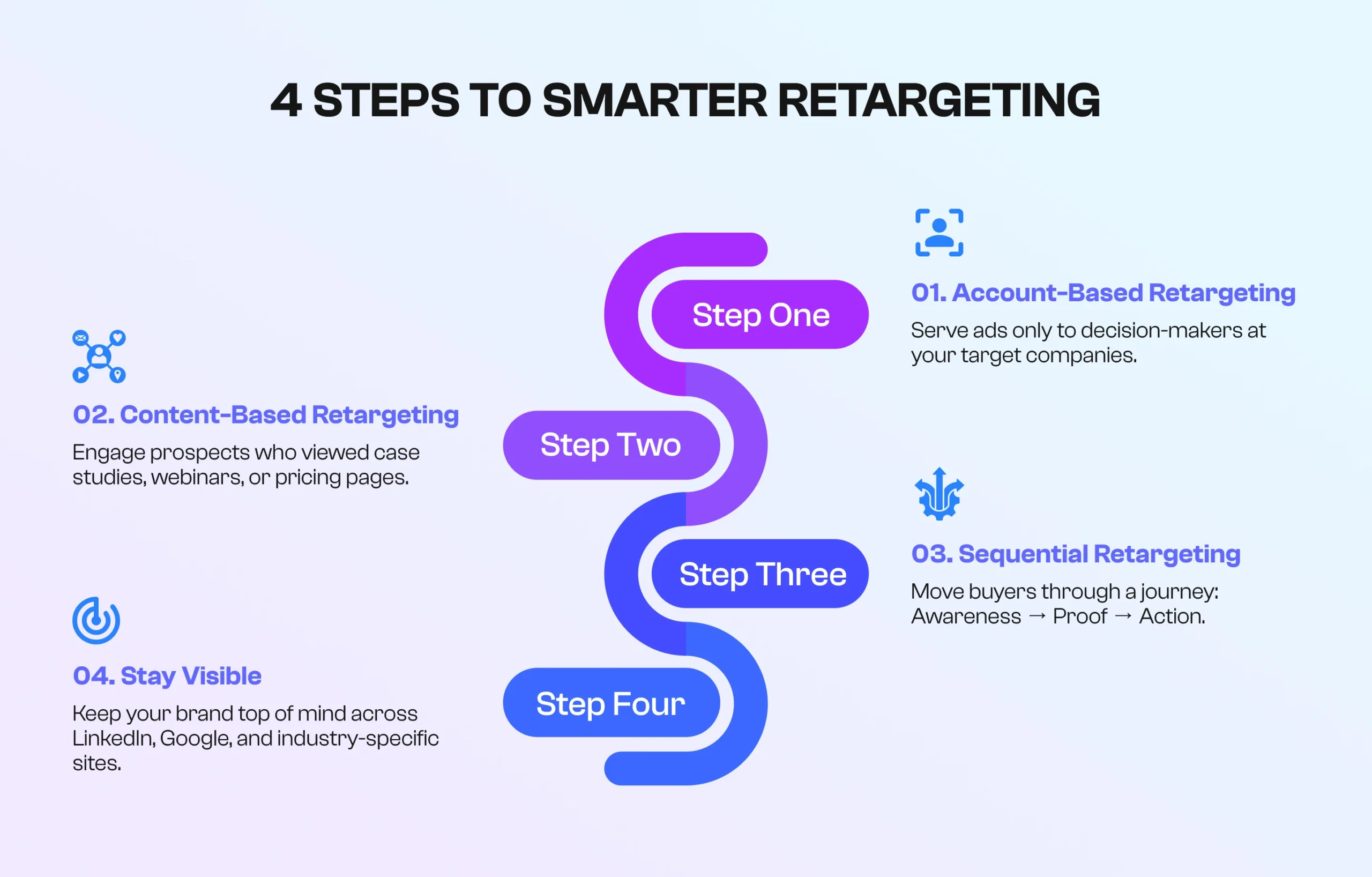
Retargeting: Cheap, Effective, Non-Negotiable
Retargeting is one of the most cost-efficient ways to stay top of mind. Cookie restrictions and privacy changes have made tracking more challenging, but platforms like LinkedIn and Google continue to allow precise retargeting for B2B audiences.
Best practices now include:
- Account-based retargeting: serving ads only to decision-makers at your target companies.
- Content-based retargeting: showing ads to people who’ve visited case study pages, webinars, or pricing sections.
- Sequential retargeting: moving prospects through a journey; first awareness, then proof, then direct CTA.
Retargeting ads have a 10x higher click-through rate than standard display ads.
Types of Ads That Work
Not all ads are equal. In B2B lead generation, the goal isn’t direct sales but engagement and credibility. Here’s what’s working in 2025:
- LinkedIn Sponsored Content remains the king for reaching professionals, especially with precise targeting options (job title, industry, company size).
- Video ads: short, authentic videos explaining pain points and outcomes outperform text-heavy ads.
- Podcast sponsorships: niche but powerful, putting your message into the ears of industry insiders.
- Display retargeting: less flashy, but effective for reminding prospects who’ve already been on your site.
Integration With Outreach
The magic happens when ads are tied to your outbound efforts. For example:
- Run LinkedIn ads targeting the same accounts you’re emailing.
- Retarget prospects who clicked your email link but didn’t book a call.
- Use ad impressions as a pre-call warmup (“I saw your ad on LinkedIn, looks like you’re growing fast”).
This kind of integration blurs the line between marketing and sales. Buyers don’t care which department owns the channel; they just notice that your brand feels familiar, credible, and relevant.
B2B ad spend is rising, but you don’t need massive budgets to make it work. Many teams see results with $2,000–$5,000/month in focused LinkedIn campaigns tied to outreach. The key is alignment: ads aren’t running in isolation, but as part of a coordinated sequence that strengthens your overall omnichannel lead generation strategy.
Events & Communities – Where Relationships Go Beyond Outreach
Some of the best B2B conversations don’t start in the inbox, on LinkedIn, or even on the phone. They typically begin in a community Slack channel, during a webinar Q&A session, or at a niche industry event. Buyers are seeking partners who share knowledge, engage in the same spaces, and add value without always being sales-driven. That’s why events and communities have become a core channel for B2B omnichannel marketing and long-term relationship building.
The Shift From Transactional to Relational
Decision-makers want real interaction. Events provide them with an opportunity to ask questions, hear stories, and observe how you and your team approach things. Communities take it even further, turning one-off interactions into ongoing conversations.
Webinars That Don’t Feel Like Sales Pitches
Webinars have evolved. The days of long, boring slideshows with a thinly veiled sales pitch are over. The winning formula is concise, interactive, and outcome-focused. Case studies, live demos, and expert panels draw far more engagement than scripted presentations.
Here’s a tip: instead of making webinars about “why our product is great,” frame them around “how companies like yours solve [pain point].” This way, your product becomes an integral part of the story naturally, not forced.
Industry Communities: Slack, Discord, and Beyond
Niche communities are where prospects discuss their interests without the pressure of being sold to. Developers gather in Discords, marketers share benchmarks in Slack groups, and finance execs trade insights in private LinkedIn communities. Showing up in these spaces (answering questions, sharing resources, contributing to discussions) positions you as a peer, not a salesperson.
That’s precisely why communities like HubSAR are gaining traction. It’s a dedicated space for SDRs, sales leaders, and B2B teams to exchange playbooks, troubleshoot outbound challenges, and share results. Being active in industry-specific hubs like this builds credibility, keeps you close to market shifts, and opens doors to warmer conversations with peers who may become future buyers.
Ready to sharpen your outbound skills? Become part of HubSAR and tap into a community built for SDRs and sales teams who want real results.
In-Person Still Works
Despite the prevalence of digital channels, in-person events are making a comeback. Conferences, roundtables, and meetups offer the kind of high-touch interactions no email or ad can replicate. When a prospect shakes your hand, hears you speak on stage, or chats with you at a booth, the relationship accelerates. Many enterprise deals still start with an event conversation, making them an underrated pillar of effective omnichannel lead generation.
How Events & Communities Tie Into Omnichannel
Events and communities reinforce every other touchpoint.
- Email invites prospects to a webinar.
- LinkedIn posts recap the key takeaways.
- Retargeting ads promote the on-demand recording.
- Calls reference shared event experiences (“I saw you attended our panel last week…”).
Each interaction feeds the others, creating a cycle of familiarity and trust.
If your brand is absent from the spaces where those peer conversations happen, you’re invisible when it matters most. By investing in events and communities, you’re building authority, relevance, and long-term relationships that matter.
Talk to SalesAR today and start building an omnichannel pipeline that actually works, with every touchpoint reinforcing the next.
Key Principles of Omnichannel Strategy
Too many teams launch campaigns in silos and wonder why results stall, because they lack a structured omnichannel lead generation framework. The secret is alignment: channels, data, and messaging all pulling in the same direction.
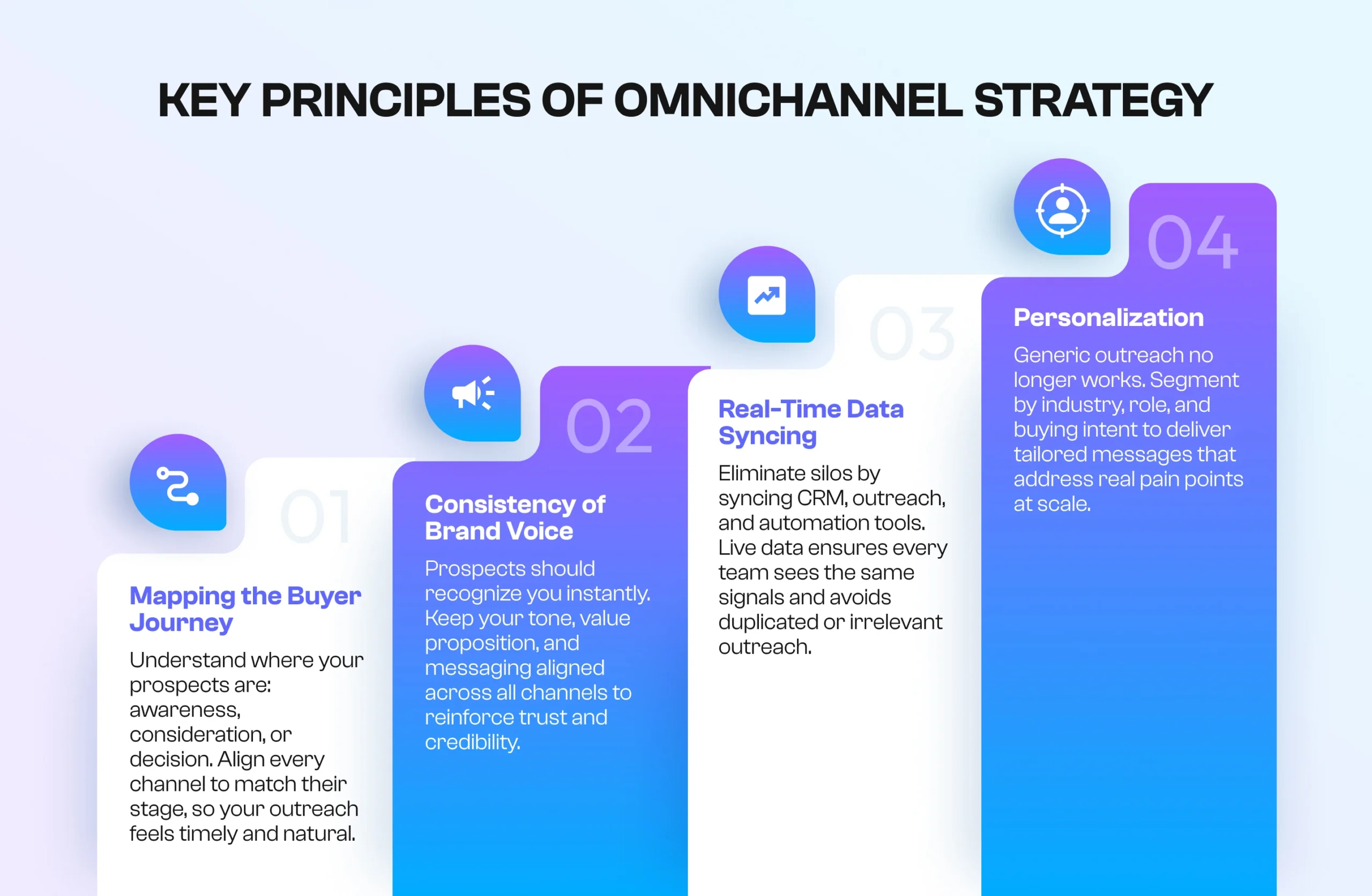
Mapping the Buyer Journey
Not every prospect is ready for a demo after the first email. Some are just becoming aware of their problem, others are evaluating solutions, and a few are ready to buy. If you blast the same message to all of them, you’ll miss more than you’ll win.
That’s why mapping the buyer journey is critical, not just in single-channel or multichannel lead generation, but especially in omnichannel systems where timing matters most. Ask:
- What does awareness look like in my ICP?
- Where do they go for research?
- What signals show they’re in an active buying stage?
Then, match channels to those stages. For example:
- Awareness: thought leadership on LinkedIn, podcast appearances, targeted ads.
- Consideration: case studies via email, retargeting sequences, and community engagement.
- Decision: phone calls, tailored demos, event invites.
This way, every touchpoint feels natural, not forced.
Consistency of Brand Voice
A significant mistake companies make is sounding like five different people across multiple channels. The tone in your emails should align with what prospects see in your LinkedIn posts, ads, and webinar Q&As. If one channel feels stiff and formal while another is casual and approachable, you create friction.
Whether you’re emailing a VP, retargeting them with an ad, or chatting in a community thread, they should recognize your brand personality instantly. That recognition fosters familiarity, and familiarity in turn builds trust; something multichannel lead generation often fails to deliver because the story changes across platforms.
Real-Time Data Syncing
Omnichannel without synced data is chaos. If your CRM doesn’t talk to your email platform, and your ad targeting doesn’t reflect the latest account updates, you’ll end up double-touching prospects with irrelevant messaging.
There’s no excuse for not having real-time syncing between your CRM, sales engagement platform, and marketing automation tools. Whether you’re on HubSpot, Salesforce, or Pipedrive, the goal is the same: every rep sees the same live data. Did a prospect click an ad? Open a webinar invite? Book a call? That activity should update everywhere instantly.
This eliminates blind spots and ensures your outreach feels coordinated rather than chaotic.
Personalization
The phrase “at scale” used to be an excuse for generic messaging. Not anymore. With the rise of AI-powered enrichment and segmentation, you can now personalize to industry, role, and even intent signals.
Practical example:
- Industry-based: highlight case studies relevant to SaaS vs. manufacturing.
- Role-based: speak to a CFO about ROI, while showing a Head of Sales how you boost the pipeline.
- Intent-based: if a lead has visited your pricing page twice, follow up with a direct demo offer instead of an awareness ebook.
Companies using segmented personalization have seen a 760% increase in revenue from email campaigns.
Omnichannel lead generation is effective when it feels seamless to the buyer, and when teams apply structured omnichannel prospecting methods that align with each stage of the buyer’s journey.
When your emails, calls, ads, and events are consistent, data-backed, and personalized, prospects don’t feel like they’re being marketed to. They feel like they’re being guided toward a solution. And that’s the difference between campaigns that generate a trickle of leads and those that keep your pipeline full year-round.
Challenges & How to Overcome Them
Omnichannel lead generation sounds excellent on paper, but anyone who’s tried it knows it’s messy in practice. Multiple platforms, different data sources, endless messages flying around — it can feel overwhelming fast. The good news? Most of the challenges are solvable if you approach them with a structured approach instead of brute force.
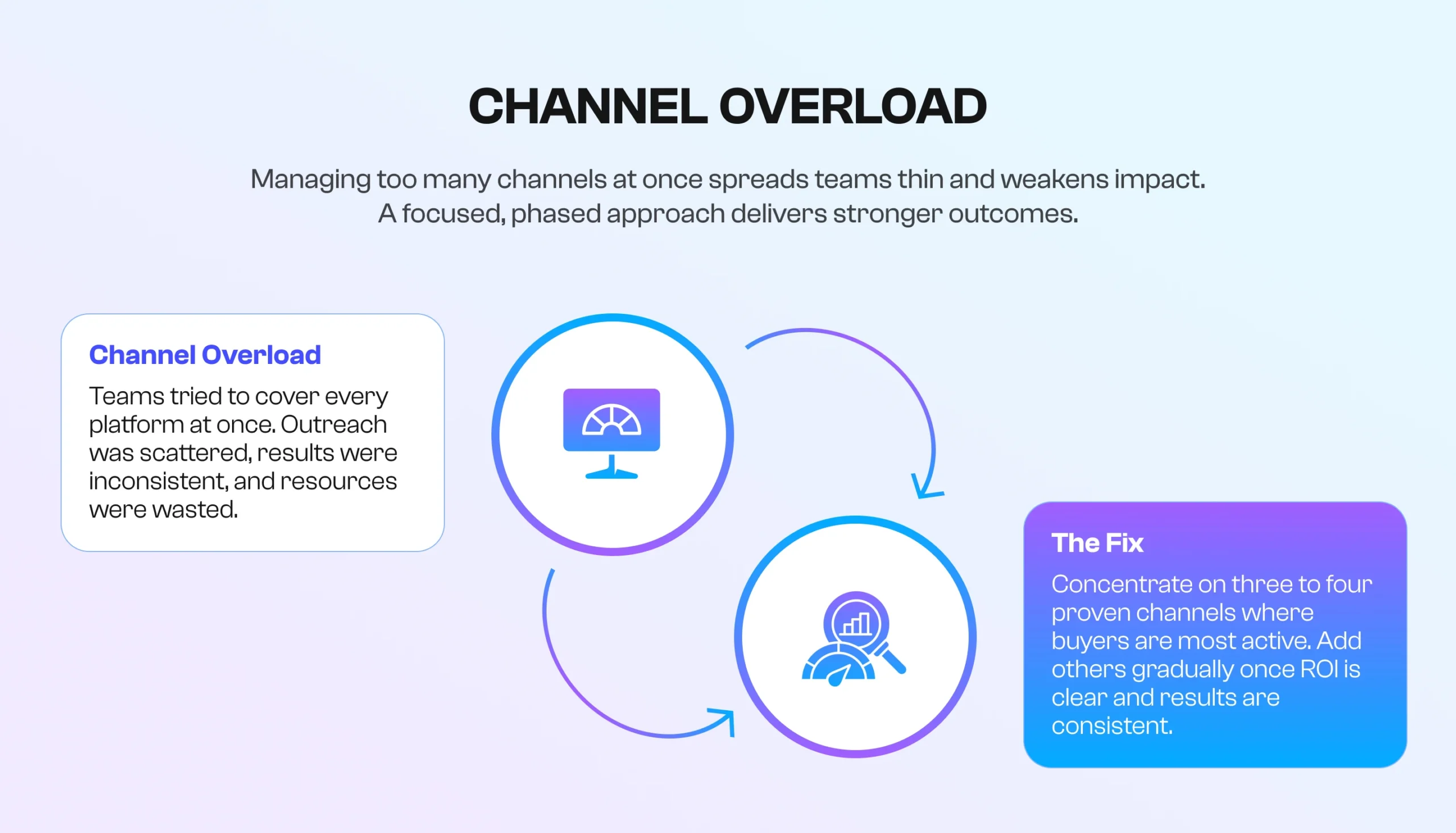
Channel Overload
It’s easy to fall into the trap of thinking “omnichannel” means “every channel.” Email, LinkedIn, X (formerly Twitter), TikTok, podcasts, trade shows, and industry forums. The reality is that no sales or marketing team has unlimited time, budget, or energy to run all of them effectively. Spreading too thin usually leads to half-hearted campaigns that don’t move the needle and frustrate your team.
Instead, omnichannel success comes from selective focus. You want to show up where your buyers already are, not chase every shiny new platform. When you’re thoughtful about channel selection, each touchpoint reinforces the next, rather than pulling you in ten different directions.
The fix: prioritize and phase in channels strategically.
- Audit your ICP’s habits: Ask where your decision-makers spend time. SaaS founders might scroll LinkedIn and listen to podcasts, while manufacturing execs may prefer email and industry trade shows. Match your effort to their attention.
- Start with 3–4 proven channels: Most B2B teams see success with a foundation of email, LinkedIn, phone, and retargeting ads. Nail these before you expand.
- Measure channel ROI early: Track meetings booked, reply rates, and pipeline contribution per channel to optimize performance. If a channel isn’t pulling its weight, reallocate the budget instead of forcing it.
- Layer in additional channels gradually: Once your core stack delivers consistent ROI, test one new channel at a time (e.g., webinars, podcasts, Slack communities). Give it 60–90 days before deciding if it stays.
- Think investment, not experimentation: Treat each channel like an asset class. Diversify enough to reduce risk, but avoid over-diversification that dilutes returns.
When you narrow your focus, multichannel lead generation becomes manageable, and omnichannel lead generation services turn from theory into scalable execution. Instead of chasing every platform, you build a repeatable system that grows stronger as each channel reinforces the others.
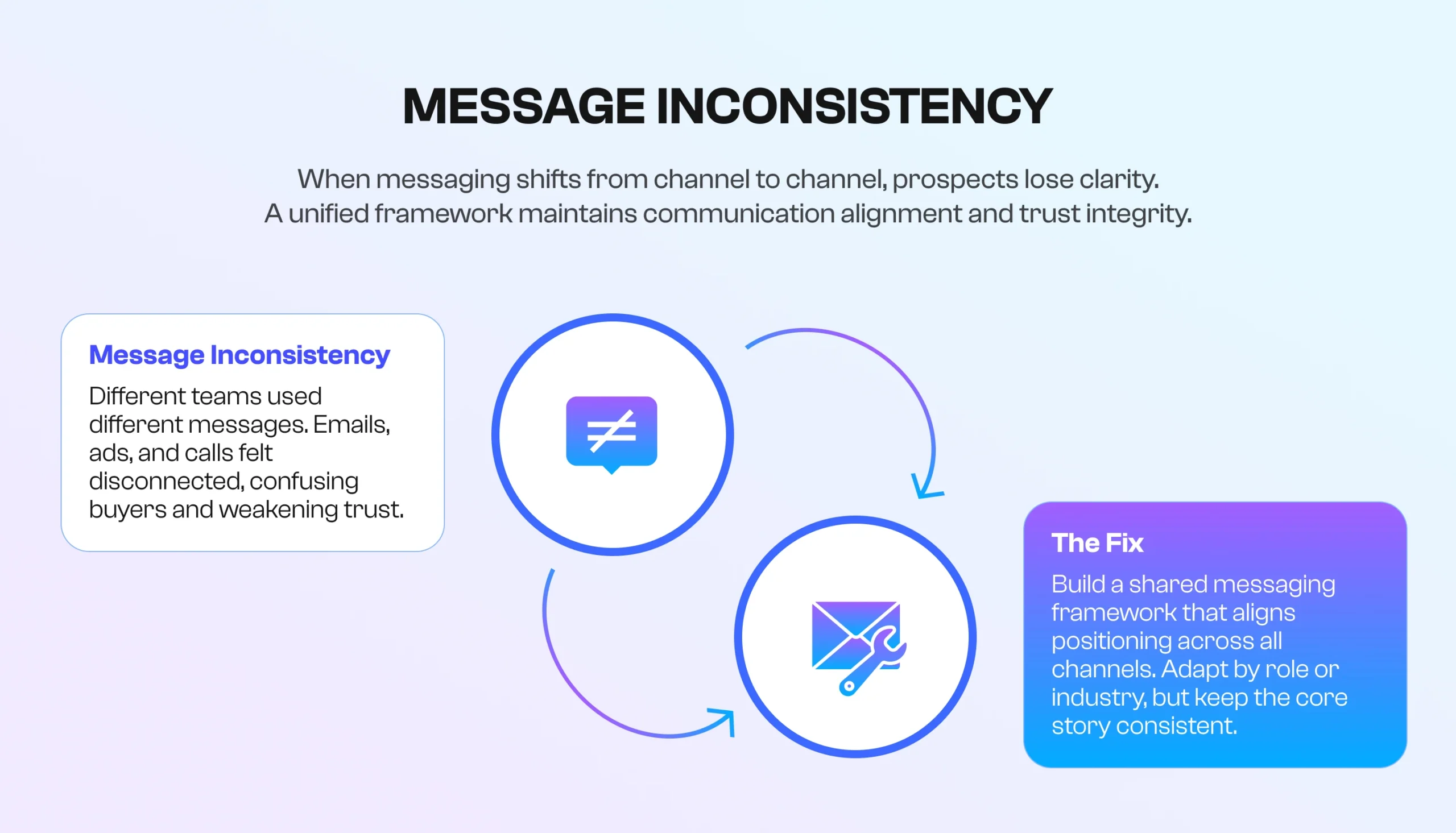
Message Inconsistency
One of the fastest ways to lose a buyer’s trust is by sounding like five different companies across five other channels. Maybe your ad says you help teams “scale faster,” your email promises “cost savings,” and your SDR’s call pitch focuses on “innovation.” Each angle might be true, but to the buyer, it feels disjointed. Instead of reinforcing your value, you confuse them.
Consistency doesn’t mean repeating the exact phrase everywhere. It means maintaining the core narrative while adapting the angle to suit the role, industry, or stage of the journey. When every channel points back to a unified story, prospects start to believe it.
The fix: build a messaging framework your whole team follows.
- Define the core positioning: Write one clear sentence: “We help [ICP] solve [problem] by [unique value].” This is the anchor. Every message, across every channel, ties back to it.
- Create role-specific variations: CFOs care about ROI, Heads of Sales want pipeline growth, and CTOs wish for reliability. Build 2–3 messaging pillars for each role to keep personalization aligned.
- Adapt by industry: Use sector-specific proof points (SaaS case studies for software, compliance wins for fintech). That way, your message feels relevant without drifting off-brand.
- Document and share: Put the framework in a playbook that sales, marketing, and SDRs can all access. Make it the single source of truth so no one freelances their own story.
- Review quarterly: Markets shift, products evolve. Revisit the framework every few months to ensure the core narrative continues to reflect your strengths and buyer priorities.
With a framework in place, every email, LinkedIn post, ad, and call will sound like different chapters of the same story.
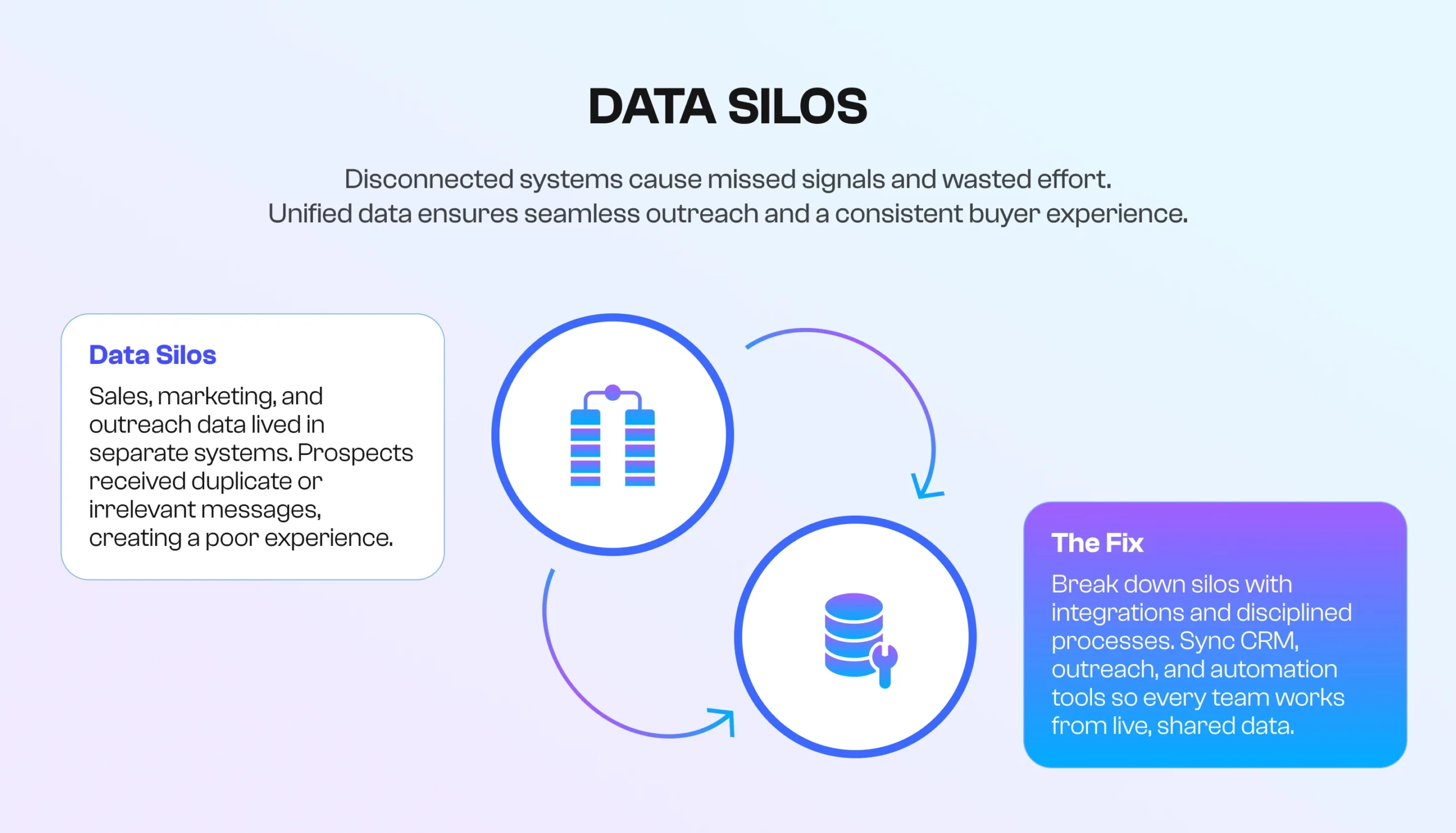
Data Silos
Few things frustrate buyers more than being treated like strangers after multiple interactions. Imagine receiving a cold email the day after you’ve already booked a demo, or seeing retargeting ads for a product you’ve just bought. These slip-ups happen when sales and marketing teams run on disconnected systems.
Outreach logs sit in one platform, ad data in another, and CRM updates lag. The result? Missed signals, wasted spend, and an experience that feels sloppy instead of seamless.
Omnichannel only works if data is transmitted in real-time. Every rep, marketer, and manager should see the same up-to-date information: what prospects clicked, downloaded, attended, or said on a call. Without that visibility, you’re running parallel campaigns that collide.
The fix: break down silos with integrations and process discipline.
- Make CRM the single source of truth: Salesforce, HubSpot, or Pipedrive should hold the master record. All updates (calls, email replies, ad interactions) sync here. If it’s not logged in CRM, it didn’t happen.
- Integrate outreach tools: Connect Salesloft, Outreach.io, or Instantly with your CRM so emails and sequences automatically update lead records.
- Sync marketing automation: Platforms like Marketo or HubSpot Marketing should feed campaign data (opens, clicks, webinar sign-ups) directly into CRM contact timelines. That provides SDRs with context before they make a call.
- Pull in intent data: Use 6sense, Bombora, or ZoomInfo intent signals to enrich CRM records with account-level buying behavior. This prevents sales from chasing cold accounts while warm ones are ignored.
- Build shared dashboards: Create pipeline and engagement dashboards visible to both sales and marketing.
Buyers notice the difference and reward you with replies instead of unsubscribes.
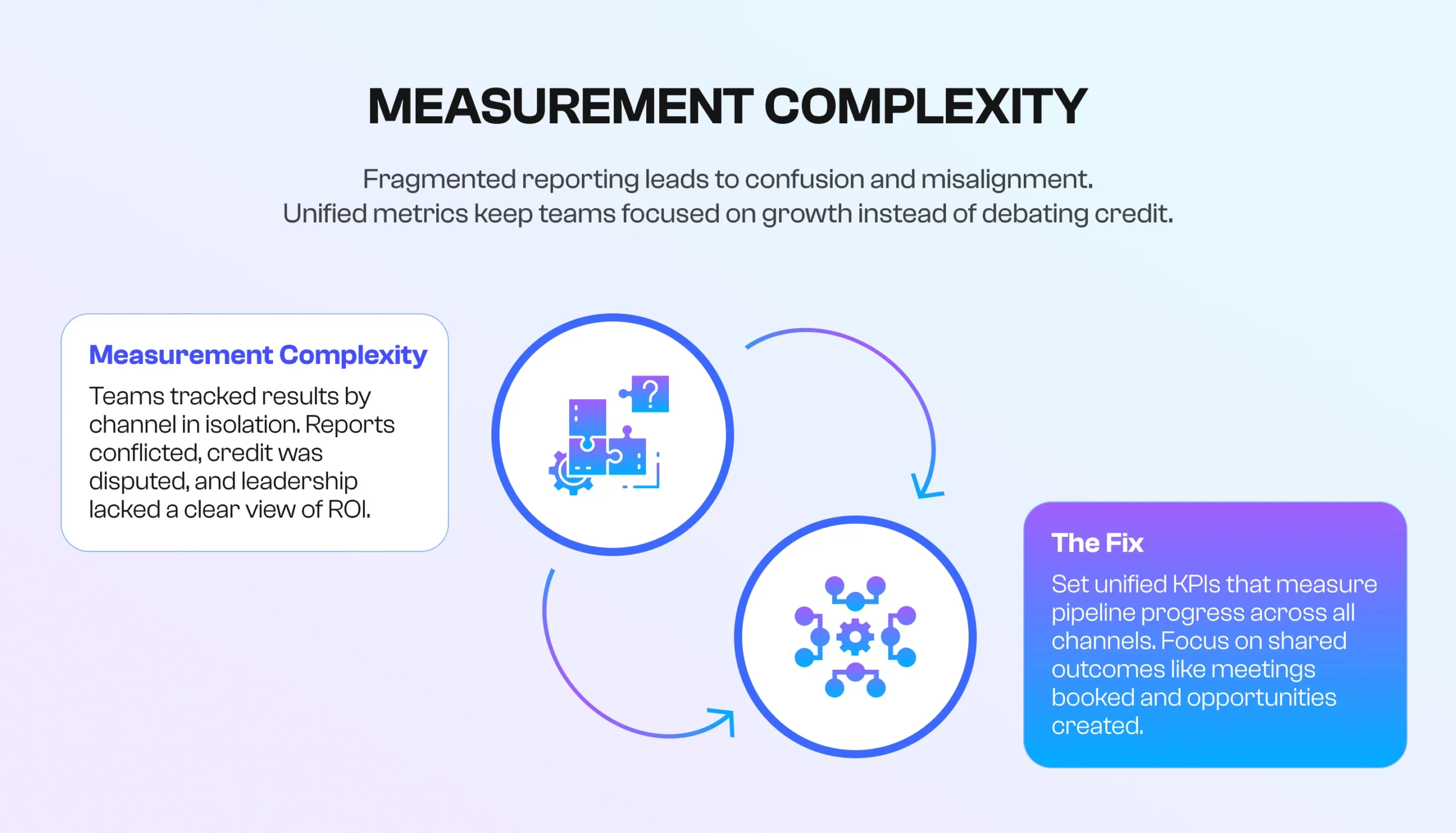
Measurement Complexity
Omnichannel outreach makes attribution messy. Did the initial cold email spark the deal? Was it the retargeting ad that finally piqued interest? Or did a comment on LinkedIn create the real breakthrough? Teams can waste hours debating which channel “deserves” credit, losing sight of the bigger picture: did the account move closer to generating revenue?
The challenge grows as more channels get added. Marketing reports ad impressions, SDRs track calls, and sales track the pipeline, but none of it lines up neatly. Without a unified approach, you end up with fractured reporting, frustrated teams, and leadership unsure of where the budget is actually being spent.
The fix: set unified KPIs that focus on pipeline progress, not channel ego.
- Define shared outcomes: Agree on the metrics that matter across sales and marketing upfront, such as the number of meetings booked, opportunities created, and the sales-qualified pipeline.
- Track blended reply/response rates: Instead of siloed stats (email replies vs. LinkedIn replies), measure engagement per account across all channels touched. This shows the actual impact of omnichannel activity.
- Measure multi-channel influence: Monitor the number of opportunities generated from accounts engaged on three or more channels. This demonstrates that integrated outreach is more effective than single-channel efforts.
- Set cost per sales-qualified appointment: Roll up ad spend, SDR hours, and tech costs to calculate the real efficiency of your system. This aligns finance, marketing, and sales around ROI.
- Use dashboards that everyone can see: Centralize reporting in the CRM or BI tool so that sales and marketing work from the same data, rather than using dueling spreadsheets. Transparency kills turf wars.
By simplifying measurement into shared, outcome-driven KPIs, you shift the conversation from “who gets credit” to “are we generating pipeline?” The most effective teams often partner with a lead generation agency that employs an omnichannel approach to facilitate this alignment.
Conclusion
Buyers expect to meet you on their terms, across multiple touchpoints, with a message that feels consistent and relevant every time. One channel alone won’t cut it. The companies that win are those building seamless systems where email, LinkedIn, calls, ads, and communities reinforce each other, rather than competing for attention. Working with an experienced omnichannel marketing company or investing in B2B lead generation solutions ensures you stay ahead, not just today but in the years to come.
The future of sales development hinges on three key factors: personalization at scale, brand consistency across all channels, and seamless data integration, ensuring every interaction feels coordinated. When those pieces come together, outreach stops looking like cold campaigns and starts feeling like genuine buyer guidance.
SalesAR can design the omnichannel pipeline that keeps your sales team winning.

